Key Takeaways
- Two university-wide surveys about students' mobile technology ownership and learning practices show that mobile device ownership is high and continues to increase among students.
- Students and instructors need technical, logistical, and pedagogical support for integrating mobile devices and apps in formal and informal learning environments.
- Continuous support and targeted training resources at the University of Central Florida have produced positive changes in students' mobile learning practices.
Baiyun Chen, Ryan Seilhamer, Luke Bennett, and Sue Bauer, Instructional Designers, University of Central Florida
Mobile technology is ubiquitous in the lives of today's college students. Although 83 percent of adults between the ages of 18 and 29 own a smartphone,1 mobile device ownership among college students is even higher; according to a 2014 EDUCAUSE report, 86 percent of undergraduates owned a smartphone as of last year, and nearly half (47 percent ) owned a tablet.2
As an integral part of students' daily lives, mobile technology has changed how they communicate, gather information, allocate time and attention, and potentially how they learn. The mobile platform's unique capabilities — including connectivity, cameras, sensors, and GPS — have great potential to enrich the academic experience.3 Learners are no longer limited to the classroom's geographical boundaries, for example; they can now record raw observations and analyze data on location. Furthermore, mobile technology platforms let individuals discuss issues with their colleagues or classmates in the field. The ever-growing mobile landscape thus represents new opportunities for learners both inside and outside the classroom.4
We conducted two surveys — one in 2012 and one in 2014 — to investigate student use of mobile technology. As a basis of our survey questions, we used the Advanced Distributed Learning Initiative definition of mobile learning:
Leveraging ubiquitous mobile technology for the adoption or augmentation of knowledge, behaviors, or skills through education, training, or performance support while the mobility of the learner may be independent of time, location, and space.5
We targeted University of Central Florida (UCF) students who use mobile devices such as smartphones, tablets, and e-book readers, and focused our questions on their mobile learning activities both inside and outside of classrooms.
Key Issues
Despite high ownership, longitudinal data indicates that use of mobile technology in learning is not as widespread as the devices themselves.6 A recent Box survey shows that 50 percent of students reported that they do schoolwork daily from smartphones or tablets,7 which is a relatively small percentage compared to the 86 percent ownership statistics.8 Also, students are not as adept at using mobile technology as the devices' popularity suggests. In short, ownership does not have a direct relationship to proficiency.
Effective use of mobile technology is less about tools and more about students' digital literacy skills, including the ability to access, manage, and evaluate digital resources.9 Students might take plenty of pictures using their mobile phone cameras, but rarely do they use the device for meaningful learning experiences. So, even though students recognize mobile devices' value for academic work, they still look to institutions and instructors for opportunities and encouragement to use them that way.10
Use of mobile technology in the classroom is even rarer. A recent study found that only 30 percent of instructors incorporate mobile technology into assignments, and 55 percent actually ban or discourage classroom use of mobile devices.11 Like other innovations, mobile technology is often perceived as a distraction in traditional learning environments; the study found that many students (47 percent ) and instructors (67 percent ) shared this concern.12 However, in traditional assignments, such as textbook reading and classroom discussions, instructors can easily control the feed of information and pace of learning.
Mobile devices' just-in-time connectivity both enables new learning opportunities and raises challenges for instructors and students. Even when instructors are willing to embrace this new form of learning technology in the classroom, they often face hurdles with infrastructure and support.13 Researchers who conducted a mobile survey at Boise State University found that faculty lacked the necessary support and resources to successfully integrate mobile learning technology into the classroom learning experience.14 Similar findings were reported in another mobile survey at the University of Florida.15
Technology adoption in higher education is more than applying technical innovations. Wide-scale institutional implementation requires clear university policy, device availability, and readily accessible technical and pedagogical support. A lack of effective training to ensure that faculty have the skills they need to guide students is tied to institutional issues ranging from funding shortages to low administrative and technical support to a lack of formal digital literacy agendas.16
Previous research explores big trends — such as device ownership among students and faculty 17— but does not delve into student learning practices. The goals of our multi-year research are to
- investigate mobile learning practices and their impact on students' academic life;
- seek out pedagogical insights that will help instructors better embrace mobile technologies in their curriculum; and
- provide concrete strategies for students and instructors who wish to implement mobile learning in their particular academic setting.
Our effort was guided by three research questions:
- Which mobile devices do UCF students have for accessing and engaging with digital content? Are there demographic factors that influence access?
- How do college students use mobile technologies (devices and apps) for learning purposes? Are there demographic factors that influence this use?
- What are the key developments in mobile practice between the 2012 and 2014 surveys?
Survey Methods
We distributed the 2014 survey during spring semester and based it on the 2012 survey,18 which gave us a general overview of the mobile technology ownership and usage landscape among students. In the 2014 survey, our goal was to measure changes in that landscape; it also contained additional questions aimed at obtaining more in-depth information about mobile technology and its use in academic settings. The survey featured various question types, including some that let participants expand on their responses. UCF's Institutional Review Board approved the survey. We also invited expert reviewers to test the survey's validity.
We distributed the survey through an e-mail sent to all students, as well as announcements in courses that granted us permission. We collected data (N = 1,181) from both undergraduate (n = 1,075) and graduate (n = 106) students currently enrolled in three types of courses: face-to-face, fully online, and mixed mode. Participants represented 12 different colleges at UCF and 83 different courses. Approximately 68 percent of the respondents were female and 22 percent were male. More than half (63 percent ) were Caucasian, 18 percent were Hispanic, 7 percent were African-American, and 6 percent were Asian. The age range of the respondents was 18–64 (M = 24; SD = 7.04).
Survey Results
Our surveys focused on our three research questions; the results follow.
Question 1: Device Ownership
Our collected data indicated that more than 95 percent of respondents (N = 1,181) owned a smartphone device (see figure 1). As figure 2 shows, most students owned either an iPhone (66 percent ) or an Android (30 percent ). As figures 1–4 show, tablet and e-book reader ownership is relatively low compared to smartphone devices. Overall, 57 percent of students own tablets; of those, 36 percent own an iPad and 21 percent own an Android tablet (see figure 3).
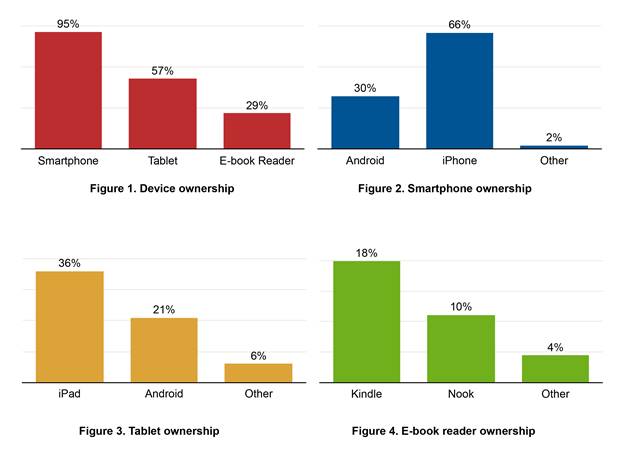
Smartphone ownership was prevalent among students regardless of demographic factors, but academic standing, age, and gender played a role. In general, younger students reported owning more smartphones than older students (r(1,159) = -0.135, p < 0.01). However, older students reported owning more tablets (r(1,150) = 0.131, p < 0.01) and e-book readers (r(1138) = 0.172, p < 0.01) than younger students. In terms of academic level, graduate students owned tablet devices more than undergraduate students (X2(2, N = 1,171) = 7.92, p = .02). Specifically, 68 percent of graduate respondents reported owning a tablet device, compared to 55 percent of undergraduate respondents. Gender had a small but significant impact on tablet ownership, with female students owning more tablets (X2(3, N = 1,171) = 7.92, p = .01) and e-book readers (X2(3, N = 1,158) = 9.549, p = .02) than male students. Specifically, for female respondents, 59 percent reported owning a tablet and 32 percent an e-book reader, compared to 49 and 23 percent of male respondents, respectively.
As figure 5 shows, students use various mobile apps extensively in their personal lives, with the most frequent use reported for apps that let them check social networking sites, listen to music, and view social media.
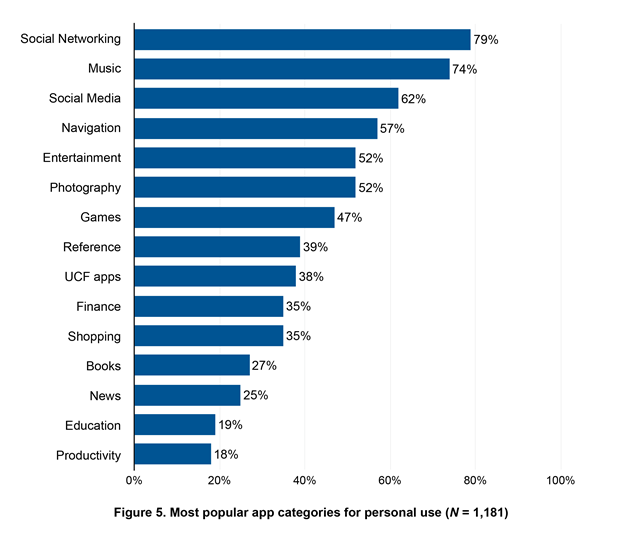
When we asked students how they would like UCF to use mobile apps and devices in the future, they listed several UCF apps they would like to access on their devices for academic and nonacademic purposes. The most desired UCF apps were: MyUCF (UCF's Portal), Campus Maps, Campus Phonebook, and Campus Events, all of which were mentioned by 61–78 percent of respondents. A few students requested that the UCF Maps app be GPS-enabled to show a student's location on campus (currently, the app displays only building locations). Some also suggested a community-building feature that would let local businesses promote food specials, prize giveaways, and events.
Question 2: General App Usage
A key goal of our survey was to better understand how students use mobile devices inside and outside the formal learning context. As figure 6 shows, we found a large difference between instructors requiring mobile device use in coursework and students using the devices for their own learning.
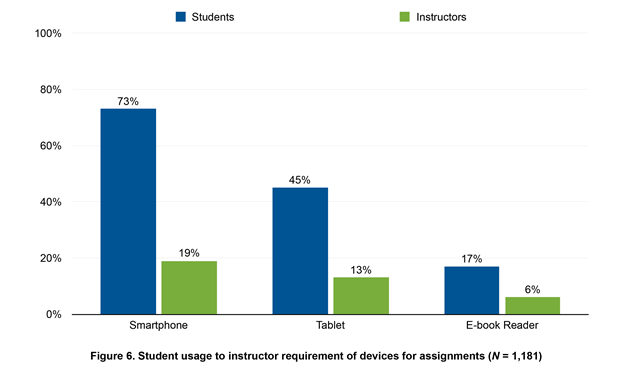
For learning on their own, students reported using smartphones (73 percent) more than tablets (45 percent ) and e-books (17 percent ). Furthermore, 66 percent of students (n = 781) reported using a mobile app for learning at least once each week. However, according to our participants, instructors rarely required mobile device use to complete assignments; respondents said only 19 percent of instructors required smartphone use, 13 percent required tablets, and 6 percent required book readers. Our open-ended questions to students supplemented the findings: students reported using devices to look up lecture topics during face-to-face class time; they use discipline-specific apps to access knowledge and other mobile apps to access course textbooks both during and outside of class.
We asked students about the benefits of using mobile apps/devices for academic purposes. Using a 5-point Likert scale from strongly agree to strongly disagree, students (N = 1,181) agreed or strongly agreed that using apps and devices
- makes it easier to access coursework (72 percent),
- increases communication with other students (65 percent),
- increases communication with instructors (60 percent),
- increases my knowledge in my field of study (48 percent),
- improves my quality of work (43 percent), and
- increases motivation to complete coursework (42 percent).
Reviewing demographic results, younger students reported using smartphones for learning more often than older students (r(1,155) = 0.142, p < 0.01). Conversely, older students reported using tablets (r(1,138) = -0.115, p < 0.01) and e-book readers (r(1,121) = -0.165, p < 0.01) for learning more often than younger students. Regarding academic levels, freshmen, sophomores, and juniors reported using smartphones for learning more than seniors and graduate students (X2(20, N = 1,176) = 32.40, p = .04), and juniors, seniors, and graduate students reported using e-book readers for learning slightly more than freshmen and sophomores (X2(20, N = 1,139) = 35.41, p = .02).
The academic apps students reported using regularly included university apps (such as the UCF Web site, Webcourses@UCF-Canvas, Tegrity, MyUCF, and UCF Mobile); apps for education (such as Quizlet, Flashcards, Pearson, and Duolingo); books (such as CourseSmart and iBooks); references (such as Dictionary and Wikipanion); and productivity apps (such as Evernote, Dropbox, Microsoft products [http://www.cst.ucf.edu/wp-content/uploads/Knights-Email-Office-365-Overview.pdf], Keynote, and Notes [http://www.apple.com/iphone/built-in-apps/]).
When asked about the use of UCF-specific apps, 65 percent of students said they use Webcourses@UCF-Canvas (the mobile app for our learning management system), and 55 percent said they use UCFMobile. Most said they use the UCF's mobile apps on-the-go for informal information. Their preference is to use desktop computers and/or laptops for submission of assignments, assessments, and formal UCF communications.
Reviewing demographics, race is the only factor that related to students' reported use of mobile apps for learning purposes. Students identifying as Caucasian reported using mobile apps for learning less than other races (X2(35, N = 1,178) = 53.13, p = .03). Approximately 14 percent reported using mobile apps for learning several times a day vs. about 20 percent among African, Asian, and Hispanic Americans.
Question 3: Survey Comparison
We completed a comparative analysis between the data collected from the survey distributed in 2012 and the data collected from the 2014 survey. Here, we highlight the key developments in mobile practice over those years, but we recommend interested readers view our mobile infographic [https://digitallearning.ucf.edu/msi/files/2014/10/mobile-comparison.pdf] for additional comparison information.
Although the two surveys were not identical, we compared similar items to evaluate changes in data between the distribution years (see figure 7). Overall smartphone ownership increased only mildly (3 percent), but iPhone ownership increased substantially (20 percent), while Android ownership decreased (4 percent). Tablet ownership also increased (26 percent), with iPads accounting for the largest increase (15 percent) during that time.

Figure 7. Device ownership comparison, 2012 and 2014
As figure 8 shows, percentages did not significantly increase in use of social and music apps, which remained the two highest categories at 79 and 74 percent, respectively. Students did report an increase in use of some apps, including navigation (from 48 to 57 percent), entertainment (47 to 52 percent), and books (19 to 27 percent). However, the largest increases were in the categories of reference (from 17 to 39 percent), UCF apps (from 24 to 38 percent), and photography (from 38 to 52 percent). Interestingly, students decreased their use of mobile technology for games in 2014 (from 53 to 47 percent).
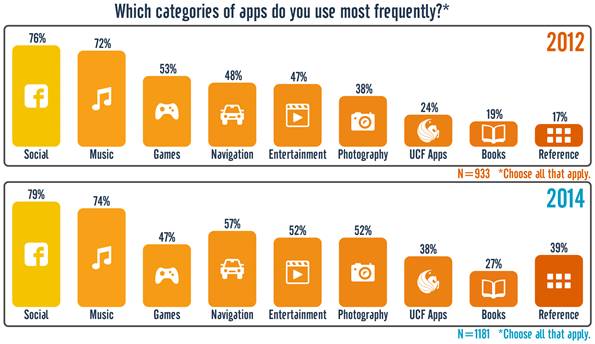
Figure 8. Mobile device application use by category, 2012 and 2014
A considerable percentage of students (39 percent; n = 458) indicated that they wanted their instructors to use mobile apps in course activities; they also indicated that a few instructors were actually doing so. However, some apprehension on the students' part was evident, as figure 9 shows. When mobile technology was used in an academic setting, students indicated that instructors typically provided limited technical support; indeed, only 35 percent of students reported any support at all when mobile app use was required. Furthermore, even fewer students (19 percent) indicated that their instructors modeled the mobile apps they expected students to use. Finally, few students (only 16 percent) reported that their instructors clearly stated the expectation that mobile apps were to be used for a given academic experience.
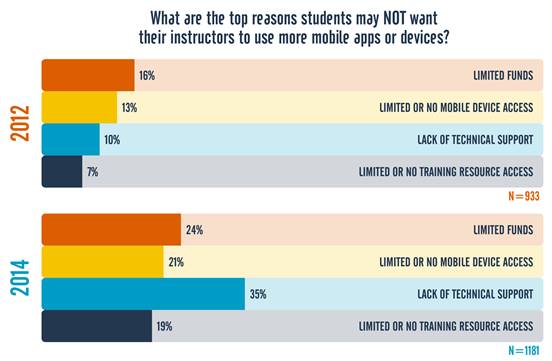
Figure 9. Reasons students cited for NOT wanting instructors to use mobile devices, 2012 and 2014
In the 2014 survey, student participants cited the following reasons for preferring that instructors avoid mobile app use altogether: lack of technical support (35 percent), limited funds (24 percent), limited or no access to mobile devices (21 percent), and limited or no access to training (19 percent). All of these percentages were significantly higher than in the 2012 survey. In addition, in the open-ended answers, students reported several technical problems, including app crashes, being logged out too frequently, and connection issues. Some students said that they downloaded the app but it didn't work and support services were not available.
Students who own devices use them for learning. However, comparisons between the 2012 and 2014 show that use for learning depended on the type of device the student owned (see figure 10). Percentages increased considerably among smartphone owners (from 58 to 77 percent), while among tablet and e-book owners, their use for learning decreased slightly (from 82 to 79 percent and 64 to 59 percent, respectively).

Figure 10. Device use for learning, 2012 and 2014
Discussion
Our results yielded three overarching practical implications that might be beneficial for promoting mobile learning both within and outside our institution.
Mobile Learning Practices
After the 2012 survey, we rolled out several initiatives aimed at both increasing student access to mobile devices and apps, and educating instructors on mobile learning. For example, we extended the features in UCFMobile and marketed it across the campus through multiple channels. More importantly, we established a faculty focus group for mobile learning to discuss how to use mobile technologies in classroom settings. During our focus group meetings, we worked with innovative instructors to design and test several mobile learning–related technical and logistical job aids, such as the mobile app checklist and the Mobile Essentials course. All of these efforts yielded positive changes in mobile practices on campus.
The survey comparison between 2012 and 2014 indicates that ownership of mobile devices continues to grow, and more students are using smartphones for learning (a 19 percent increase). The largest increase in mobile app usage was on learning-related apps, including
- reference apps, such as Google search, dictionary, Wikipanion, and WolframAlpha (22 percent increase);
- UCF apps related to students' academic life (14 percent increase); and
- instructor integration of mobile technology into academic coursework (13 percent increase).
Respondents reported a variety of mobile learning practices in the 2014 survey. When asked to provide examples of their instructors' assignments for mobile devices/apps, students said they often researched information and answers while in class; responded to in-class polls; or looked up course information such as grades, content, and assignments. Some students reported that instructors asked them to download, review, and use apps specific to their degree discipline. For example, one student said that, in one class, students were asked to use their smartphone to take a video, post it to social media, and then discuss how social media integrates with their industry.
We plan to integrate the mobile learning strategies and examples from our survey in our professional development program. Hopefully, these real-classroom mobile learning practices will inspire more instructors to embrace mobile technologies in their curriculum.
Technical and Logistical Support
Although cost and device ownership still raise concerns, the survey results indicate that a lack of technical support is the top reason that students do not want instructors to use mobile apps or devices in their coursework. Furthermore, instructors' increasing adoption of mobile technology makes it even more important that they clearly articulate the support students will have for mobile devices and apps.
If students have an issue with an online course or technology in the classroom, their support path is generally clear, timely, and precise. With mobile technologies, this is not always the case. Even common mobile applications might not have timely technical support, if they have technical support at all. Given this, instructors should consider whether they need to create support material or refer students to the app developer for tutorials and help documents.
Logistical support is also important. The 2014 survey shows that most students own and use smartphones for learning purposes, but a closer look reveals a variation by age and college level. Because younger students and underclassmen own and use smartphones for learning more often than older and graduate students, instructors of lower-level courses might consider integrating more assignments for these devices. Older students and graduates tend to own tablets or e-book readers and use them more often for learning. In conjunction with smaller class sizes, instructors might find it advantageous to use tablets and e-book readers for this demographic.
However, while the current report shows this usage pattern, it might change in upcoming years. As younger students move into upper-level and graduate courses, continued use of their preferred mobile devices seems likely. Therefore, it's important to continue conducting surveys about mobile ownership and learning, and revisiting data about the mobile landscape.
Another point to consider is student access to devices and apps. Although there's no easy solution here, some acquisition models are worth considering for higher education institutions. Among them are loans, leases, stipends, and making device and app purchases part of tuition. At UCF, the library has a short-term tablet loan program to address low tablet ownership rates. Also, the UCF community has worked with mobile service carriers to provide service and equipment discounts for students and faculty members. The university's combined efforts contributed to positive changes in students' mobile learning practices on campus.
Pedagogical Support and Professional Development
The increase in student mobile device ownership and use for coursework gives instructors a new avenue for displaying content, creating activities, and interacting with students. Although some instructors are comfortable with these emerging technologies, others will need pedagogical support and professional development to better utilize them.
Appropriate pedagogical support is based on a good understanding of students' mobile use habits and needs. To select apps that students already use (and thus lower technical support needs), instructors can examine the 2014 report for details about the most popular app categories among students. Instructors should also consider students' needs by asking them for feedback about the current mobile environment. By catering to student needs and offering matching services, instructors will see more value added to mobile devices, which can increase device ownership and user engagement.
Even though mobile technologies are more pervasive in education today, we should always ask the pedagogical question: Is mobile technology necessary to support students in reaching the intended learning outcomes?
Instructional designers and specialists can offer instructors pedagogical support by walking beside them as they outline their learning goals and teaching strategies. Once the outline is established, decisions about mobile technology's relevance to a course can be made. Mobile technology should be used only if it can support student learning and enhance the curriculum during learning experiences.
Instructional designers can play a key role in this journey by connecting instructors to checklists, searches, and best practices. UCF designers have developed three tools for pedagogical mobile app support:
- A mobile app checklist that runs through features, accessibility, cost, support, and other factors when selecting an app
- The Mobile Online Tools & Taxonomy Resource (M-OTTR) [http://mobile.cdl.ucf.edu/2014/09/10/mobile-ottr/], which lets instructors search for apps that align with their learning objectives
- The new Mobile Course Check, in which instructional designers review courses and give faculty a report that outlines the needed student support documentation and summarizes the course's ease of usability and access on a mobile device
Further, institutions can curate well-designed pedagogical support materials into professional development courses and training materials. Such courses can be designed to meet the needs of instructors, who have diverse knowledge levels about the topic. Modular courses, in which instructors can pick and choose different course or take the modules in succession, can be designed with enough flexibility to accommodate instructors regardless of their foundational knowledge level.
Professional development courses should include basic concepts, common definitions, pedagogical implications, best practices, examples, and support mechanisms. Instructors who possess more foundational knowledge on a topic can quickly examine examples of real-world execution of the technology that such a course provides, while those with less foundational knowledge can spend more time in the modules that discuss basic concepts.
Creating a professional development course can also foster collaboration among instructors interested in the technology, while creating a knowledge base of best practices for each individual instructor. Once the instructor has become comfortable using them in the classroom, these same best practices can serve as instructional examples in the course.
At UCF, we provide a variety of training opportunities for faculty, including expert testimonials, in which instructors can see technology demonstrations and learn from best practices. UCF designers have created a series of micro-stories that highlight a mobile technology's real-world use in 1,000 words or less (for examples, see the CDL Mobile Blog).
We shared our successful strategies through UCF's Teaching Online Pedagogical Repository (TOPR). In addition, UCF hosts the Mobile Essentials course to help instructors better understand mobile apps and devices. This training and support system has been effective in capturing and facilitating newer technology, and serves as an example of flexible modular design.
Conclusion
Our multi-year findings are consistent with prior research, indicating that ownership of mobile devices is high and continues to increase among students. However, mobile learning's potential has yet to be fully realized. Our results suggest that students and instructors need technical, logistical, and pedagogical support for integrating mobile devices and apps. Our future plan is to continuously update our faculty support resources and implement them on a larger scale. In particular, we plan to convert the Mobile Essentials course into a massive open online course (MOOC) format so the larger community can benefit from our efforts. We also plan to roll out our survey study to other interested institutions for comparative research.
Use of mobile technology for teaching and learning is still an emergent area for study, and more scholarly research must be conducted. Perhaps more importantly, individual experimentation is needed to understand what works, how, and why in both formal and informal learning environments. Practically, we need institutional changes that can facilitate and encourage students and instructors to integrate mobile technology into daily learning. At UCF, we continuously provide more support and resources for training our instructors. Because of these efforts, positive changes in the mobile landscape have become visible.
We welcome responses on the survey results and instructor training resources we've shared here, and hope to collaborate with other institutions on future research.
- Pew Research Center, "Mobile Technology Fact Sheet," 2014.
- Eden Dahlstrom and Jacqueline Bichsel, ECAR Study of Undergraduate Students and Information Technology, EDUCAUSE Center for Analysis and Research, 2014, 14.
- Peter Berking, Marcus Birtwhistle, Shane Gallagher, and Jason Haag, Mobile Learning Survey Report [https://adlnet.gov/adl-assets/uploads/2016/03/MOTIFSURVEYREPORT.pdf], Advanced Distributed Learning Initiative, 2013, 7; and Ryan Seilhamer, Baiyun Chen, and Amy Sugar, "A Framework for Implementing Mobile Technology," in Handbook of Mobile Learning, Zane Berge and Lin Muilenburg, eds., Routledge, 2013.
- Baiyun Chen, Ryan Seilhamer, Amy Sugar, and Mao Jin, "User Acceptance of Mobile Technology: A Campus-wide Implementation of Blackboard's Mobile Learn Application," Journal of Educational Computing Research, Vol. 49, No. 3, 2013: 327–343.
- Berking et al., Mobile Learning Survey Report [https://adlnet.gov/adl-assets/uploads/2016/03/MOTIFSURVEYREPORT.pdf], 2013, 5.
- Dahlstrom and Bichsel, ECAR Study of Undergraduate Students, 2014, 19; and Eden Dahlstrom, Diane Walker, and Chuck Dziuban, ECAR Study of Undergraduate Students and Information Technology, EDUCAUSE Center for Analysis and Research, 2013, 27.
- Emily Wright, "EDU Survey: How Are University Students, Faculty and Administrators Using Technology?" [https://blog.box.com/edu-survey-how-are-university-students-faculty-and-administrators-using-technology] blog, Box Blogs, August 8, 2013.
- Dahlstrom and Bichsel, ECAR Study of Undergraduate Students, 2014, 14.
- Helen Drenoyianni, Lampros K. Stergioulas, and Valentina Dagiene, "The Pedagogical Challenge of Digital Literacy: Reconsidering the Concept—Envisioning the 'Curriculum'—Reconstructing the School," International Journal of Social and Humanistic Computing, Vol. 1, No. 1, 2008: 53–66.
- Dahlstrom and Bichsel, ECAR Study of Undergraduate Students, 2014, 17; and Dahlstrom, Walker, and Dziuban, ECAR Study of Undergraduate Students, 2013, 22.
- Dahlstrom and Bichsel, ECAR Study of Undergraduate Students, 2014, 19.
- Ibid., 19.
- John Traxler, "Defining, Discussing and Evaluating Mobile Learning: The Moving Finger Writes and Having Writ . . . .," The International Review of Research in Open and Distributed Learning, Vol. 8, No. 2, 2007.
- Susan Shadle, Ross Perkins, Doug Lincoln, Michael Humphrey, and Eric Landrum, "A Multi-faceted, Organic Approach to a Campus-wide Mobile Learning Initiative: The Case of Boise State University," World Conference on Educational Multimedia, Hypermedia and Telecommunications, 2013, 665–672.
- Douglas Johnson, Tawnya Means, and David N. Khey, "A State of Flux: Results of a Mobile Device Survey at the University of Florida," EDUCAUSE Review, May 6, 2013.
- Larry Johnson, Samantha Adams Becker, V. Estrada, and A. Freeman, NMC Horizon Report: 2014 Higher Education Edition, The New Media Consortium, 2014.
- Dahlstrom and Bichsel, ECAR Study of Undergraduate Students, 2014, 14; Shadle et al., "A Multi-faceted, Organic Approach to a Campus-wide Mobile Learning Initiative," 2013, 5; and Johnson, Means, and Khey, "A State of Flux: Results of a Mobile Device Survey," 2013.
- Baiyun Chen and Aimee deNoyelles, "Exploring Students' Mobile Learning Practices in Higher Education," EDUCAUSE Review, October 2013.
© 2014 Baiyun Chen, Ryan Seilhamer, Luke Bennett, and Sue Bauer. The text of this EDUCAUSE Review online article is licensed under the Creative Commons Attribution-NonCommercial-NoDerivs 4.0 license.
